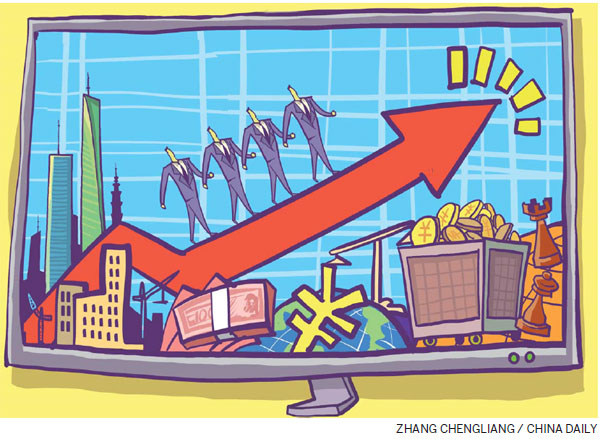2016 was turning point for economy
Prospects brighter this year because of wide-ranging changes through which China has shown its resilience
The sense of satisfaction with which the Chinese government delivered its annual work report to the joint meeting in Beijing of the 12th National Committee of the Chinese People's Political Consultative Conference and 12th National People's Congress is understandable.
The US financial crash of 2008 and the economic depression that followed it seriously unbalanced the global economic equilibrium. Globally interdependent China, which was deeply affected by the crisis, responded quickly by opening the taps of fiscal stimulus. While this response did avert economic disaster in China (and also provided vital short-term economic support to the United States and other developed countries hard hit by the financial crisis), it turned previously manageable economic structural problems into deeper and more intractable issues. These particularly include bubbles in Chinese corporate and local government debt and in real estate, and oversupply and gross inefficiency in several industrial commodity sectors.

After the feel-good glow induced by the 2008 Beijing Olympics had faded, by 2012 observers of the Chinese scene found themselves at a loss, as Chinese stock markets, both on the mainland and in Hong Kong fell back sharply from their highs and Chinese double-digit economic growth became a thing of the past. Some even projected Chinese economic collapse.
The fact is, though, that China's economy performed rather well in 2016, so that in future years it may be seen as a turning point. GDP growth in 2016 of 6.7 percent, while less than previous growth rates, still added more to global growth than any other major economy, including the United States, after exchange rate fluctuations are taken into account. State-owned sector profit growth of 8.5 percent was an important part of this, owing much to the government's previous efforts to improve management and operating efficiency. Year-on-year real disposable income growth per head of 6.3 percent continued the steady increase in the personal economic well-being of most Chinese people and was a remarkable result considering the huge size of China's population, the harshness of much of its environment and the still-difficult global economic environment in 2016.
China's success in 2016 was in maintaining a high economic growth rate, while at the same time taking some big steps toward its goal of economic transition away from low-value-added, capital intensive and often inefficient industrial manufacturing and toward more technologically intensive production and the high-value-added service industry. Ownership and management reform, and the introduction of market elements in the state-owned sector made a large impact in 2016. As these reforms develop in 2017, efficiency and productivity improvement will continue, and this will make a big difference to a very important part of China's economy.

China's ready embrace of the internet revolution, which has been encouraged and facilitated from its beginning in the late 1990s by the government, has given it world leadership in e-commerce. The "new economy" based on the internet has become a vital contributor to China's economic resilience. Chinese applications like Alipay, Taobao and WeChat provide a level of online security, convenience, efficiency and information exchange to consumers that cannot be found elsewhere in the world. China will continue to be a big beneficiary of the internet's growth in economic and social importance. The way that Chinese enterprises are grasping and using the internet to increase productivity and growth is fundamental to China's strong economic performance. For example, a key part of healthcare-sector reform is focused on using the internet to exchange patient information between and within hospitals, clinics, healthcare insurers and regulatory agencies, and between patients on the one hand, and doctors, nurses and health coaches on the other.
China has often been strongly criticized, not least by its own citizens, for its failure to control environmental pollution. But this writer, who has been a resident of Beijing since early January, can testify to the vast improvement which has taken place in Beijing's air quality this year, with day after day of blue sky and clear sunshine replacing the fog and veiled red sun of previous years. It's clear that the policy of using natural gas instead of coal to fuel Beijing's homes and power stations has already made an enormous contribution to the capital's air quality, in the same way as the ending of coal as the major heating and power source brought an end to London smog in the 1960s. China will continue to make huge and costly efforts to improve its environment. The results so far show that in a few years, major Chinese cities like Shanghai, Beijing and Guangzhou could emerge as postindustrial clean-air models for environmentalists in other countries. By 2050, much of China's landscape could rival the carefully tended environment of wealthy developed countries such as Japan.
Another excellent aspect of China's performance has been its government-led commitment to building a modern infrastructure of roads, railways (many of which are high-speed), bridges, canals, telecommunications and wastewater and disposal. The Government Work Report at the two sessions announced further expenditures in 2017 on roads, railways and bridges of over 3 percent of GDP, a level reached by few other countries, whether developed or emerging. The resilience and underlying strength of China's economy owes much to the excellent domestic road, rail and aviation links that have been created in the last two decades.
Although most of China's local government and corporate debt is denominated in domestic currency, insulating this borrowing from the risk of default to foreign creditors, and China has large enough household and corporate savings to allow it to sustain its debt, the need for structural reform remains, because a large debt overhang creates economic bottlenecks and bad incentives. The government's announcement that it will continue to work to reduce financial risk in the economy by reform and restructuring is most welcome. China's bond market has grown fast in recent years to become the world's third-largest. Increasing participation by large foreign investors in this market will help a great deal in making it into the force for greater efficiency and financial discipline the government hopes it will become. The opening up of deposit and lending rates, both key economic indicators, to market determination will further contribute to greater economic efficiency as local governments steadily move their borrowing away from local banks and opaque off-balance-sheet vehicles to transparent and liquid bond markets.
This year in particular will see an upheaval in Chinese healthcare as the government's Healthy China 2030 reforms, announced in October 2016, start to take effect. In five years, primary healthcare clinics will have replaced the long queues at certain leading hospitals, and a focus on diet, exercise and the prevention of illness will have become rooted in healthcare management.
Already in the most advanced parts of China, we can see now a new growth pattern emerging, led by consumer spending on services and discretionary items, much of which is conducted via e-commerce. Looking back at China from five or 10 years hence, I think 2016 will be seen as a year in which China demonstrated its economic resilience while also continuing to push economic transition, and realized important reforms in financial markets and the state-owned sector, which provide a foundation for the future.
The author is a visiting professor at
Guanghua School of Management, Peking University. The views do not necessarily reflect those of China Daily.
(China Daily Africa Weekly 03/10/2017 page10)
















